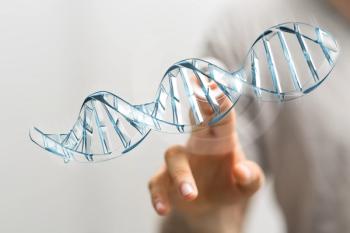Summary
- Vulvar ulcerations in children have a broad differential diagnosis, and it is important to uphold suspicion for Lipschütz ulcers in young sexually inactive girls. Knowledge of this entity may facilitate avoidance of extraneous tests and invasive procedures.
- COVID-19 infection and vaccinationcan be associated with the development of Lipschütz ulcers.
The case
An 11-year-old healthy girl presents to her pediatrician for a 1-day history of a tender bump on the labia majora accompanied by fever and sore throat. She received her 4th dose of the Pfizer COVID-19 vaccine 3 days prior to symptom onset. She denies prior sexual activity or trauma to the affected area. She is suspected to have an infection and is prescribed a 7-day course of sulfamethoxazole-trimethoprim. Over the next 2 days, the lesion worsens despite compliance to antibiotics. She is evaluated by the gynecology department and undergoes incision and drainage due to concern for abscess formation. Three days after, she presents to the emergency department because of continued increase in swelling and size of the lesion.
Examination and studies
She undergoes extensive work-up. Polymerase chain reaction (PCR) testing for SARS-CoV-2, influenza A/B, and respiratory syncytial virus is negative. Punch biopsies are negative for vasculitis, malignancy, bacterial, fungal, and acid fast bacilli cultures, and Herpes Simplex Virus (HSV) 1/2 PCR of perianal ulcerations is negative. Bloodwork for autoimmune and infectious etiologies including basic metabolic panel, rapid strep, rapid plasma reagin, human immunodeficiency virus 1/2, Epstein-Barr virus (EBV) quantitative DNA PCR, rheumatoid factor, antinuclear antibody titer, rheumatoid factor, neutrophil cytoplasmic antibody, anti-neutrophil cytoplasmic antibody, cardiolipin antibody, complete blood count are unremarkable. Inflammatory markers are slightly elevated C-reactive protein: 3.1 mg/dL (reference range <0.8 mg/dL) and erythrocyte sedimentation Rate: 28 mm/hr (reference range <25 mm/hr). The patient is discharged with close follow-up with pediatric dermatology.
Six days later, the patient presents to the pediatric dermatology clinic. Physical examination reveals a 3 cm ulcer on the left labia majora with a fibrinous center and rolled erythematous border and a surrounding erythematous indurated plaque. On the right perianal and left perianal skin on opposing surface as well as anal crease, there are a total of 3, 1 cm superficial ulcerations with surrounding erythema (Figure 1).
The pathology report reveals an epidermal ulceration with dermal perivascular and interstitial mixed inflammation (Figure 2). Gram, acid fast bacilli, and Grocott’s methenamine silver stains are negative, and immunohistochemical staining for herpes simplex virus, varicella zoster virus, and cytomegalovirus (CMV) is negative. Laboratory testing for infectious etiologies, including EBV, and autoimmune etiologies is also unremarkable.
Differential diagnosis
An array of etiologies can be considered for vulvar ulcerations in children, including infection, autoinflammatory and autoimmune conditions, and non-accidental trauma. Based upon the history and laboratory findings, the patient was diagnosed with Lipschütz ulcers (Table).
Discussion
Lipschütz ulcers, also known as reactive nonsexually related acute genital ulcerations, are painful genital lesions that most commonly occur in adolescent, sexually inactive women. They present as well-demarcated, shallow ulcers with bright red to violaceous borders and are typically at least 1 cm in diameter. The base of the ulcers can range from fibrinous to necrotic, and they may exhibit granulation tissue, purulent exudate, or adherent eschar. The labia minora are most frequently affected, while the labia majora, perinium, and lower vagina can also be involved. Isolated lesions or multiple lesions can occur; in cases with multiple lesions, ulcers are often situated on opposing surfaces, which is termed “kissing ulcers.” The pathogenesis of Lipschütz ulcers is not well understood, but it is hypothesized to be a hypersensitivity reaction to viral or bacterial infection; the deposition of immune complexes is thought to result in ulceration.1,2 History of oral aphthous ulceration may be a risk factor for developing Lipschütz ulcers, and factors such as vitamin deficiency, stress, and hormonal changes may contribute.3
Given that genital ulceration in pre-adolescent females can have broad array of etiologies, Lipschütz ulcers are considered a diagnosis of exclusion. Infectious etiologies to consider on the differential diagnosis include viral infections such as HSV, CMV, and EBV, as well as mycoplasma, bullous impetigo, and syphilis. Inflammatory and autoimmune conditions including Crohn’s disease, Bechet syndrome, pyoderma gangrenosum, and autoimmune blistering conditions should be ruled out. Bullous fixed drug eruption, hidradenitis suppurativa, and, less commonly, malignancy may be considered. A thorough history, including sexual history taken in confidence without the caregiver present, is crucial to assess for sexual abuse and accidental or non-accidental mechanical, thermal, or chemical trauma.
In this case, low clinical suspicion for sexual abuse, negative infectious studies, and unremarkable review of systems and laboratory workup for underlying inflammatory conditions pointed toward a diagnosis of Lipschütz ulcers. Skin biopsy was pursued for this patient given initial diagnostic uncertainty; however, it is important to note that histopathology is of low diagnostic utility in Lipschütz ulcers given nonspecific acute and chronic inflammatory changes that are typically seen. She tested negative for influenza and EBV, which are known viral associations with Lipschütz ulcers.4 Her findings were likely associated with the COVID-19 vaccine given temporality of receiving the vaccine prior to ulcer onset and associated transient fever and sore throat.
There have been numerous cases of vulval aphthous ulcers associated with COVID-19 infection and/or immunization reported in the literature since the onset of the COVID-19 pandemic.4-17 This novel association is important to be aware of to facilitate more prompt diagnosis and avoidance of extraneous testing.
Management
Lipschütz ulcers generally self-resolve within weeks, and treatment is primarily supportive with sitz baths as well as pain relief with oral analgesics and topical anesthetics. Topical and oral steroids have been used with good effect for multiple necrotic ulcerations.12
Patient course
The patient was prescribed clobetasol 0.05% ointment to use twice daily for a total of 3 weeks and recommended to initiate sitz baths. At dermatology follow-up 2 months later, she was found to have complete re-epithelialization of the ulcers (Figure 3).
Click here for more puzzlers.
References:
1. Moise A, Nervo P, Doyen J, Kridelka F, Maquet J, Vandenbossche G. Ulcer of Lipschutz, a rare and unknown cause of genital ulceration. Facts Views Vis Obgyn. 2018;10(1):55-57.
2. Schmitt TM, Devries J, Ohns MJ. Lipschutz Ulcers in an Adolescent After Sars-CoV-2 Infection. J Pediatr Health Care. 2023;37(1):63-66. doi:10.1016/j.pedhc.2022.09.005
3. Brambilla I, Moiraghi A, Guarracino C, et al. Recurrent reactive non-sexually related acute genital ulcers: a risk factor for Behcet's disease?. Acta Biomed. 2022;93(S3):e2022196. Published 2022 Jun 6. doi:10.23750/abm.v93iS3.13077
4. Wojcicki AV, O'Flynn O'Brien KL. Vulvar Aphthous Ulcer in an Adolescent After Pfizer-BioNTech (BNT162b2) COVID-19 Vaccination. J Pediatr Adolesc Gynecol. 2022;35(2):167-170. doi:10.1016/j.jpag.2021.10.005
5. Hsu T, Sink JR, Alaniz VI, Zheng L, Mancini AJ. Acute Genital Ulceration After Severe Acute Respiratory Syndrome Coronavirus 2 Vaccination and Infection. J Pediatr. 2022;246:271-273. doi:10.1016/j.jpeds.2022.04.005
6. Vieira-Baptista P, Lima-Silva J, Beires J, Martinez-de-Oliveira J. Lipschütz ulcers: should we rethink this? An analysis of 33 cases. Eur J Obstet Gynecol Reprod Biol. 2016;198:149-152. doi:10.1016/j.ejogrb.2015.07.016
7. Drucker A, Corrao K, Gandy M. Vulvar Aphthous Ulcer Following Pfizer-BioNTech COVID-19 Vaccine - A Case Report. J Pediatr Adolesc Gynecol. 2022;35(2):165-166. doi:10.1016/j.jpag.2021.10.007
8. Popatia S, Chiu YE. Vulvar aphthous ulcer after COVID-19 vaccination. Pediatr Dermatol. 2022;39(1):153-154. doi:10.1111/pde.14881
9. Jacyntho CMA, Lacerda MI, Carvalho MSR, Ramos MRMS, Vieira-Baptista P, Bandeira SHAD. COVID-19 related acute genital ulcer: a case report. Einstein (Sao Paulo). 2022;20:eRC6541. Published 2022 Feb 7. doi:10.31744/einstein_journal/2022RC6541
10. Falkenhain-López D, Agud-Dios M, Ortiz-Romero PL, Sánchez-Velázquez A. COVID-19-related acute genital ulcers. J Eur Acad Dermatol Venereol. 2020;34(11):e655-e656. doi:10.1111/jdv.16740
11. Christl J, Alaniz VI, Appiah L, Buyers E, Scott S, Huguelet PS. Vulvar Aphthous Ulcer in an Adolescent With COVID-19. J Pediatr Adolesc Gynecol. 2021;34(3):418-420. doi:10.1016/j.jpag.2021.02.098
12. Rosman IS, Berk DR, Bayliss SJ, White AJ, Merritt DF. Acute genital ulcers in nonsexually active young girls: case series, review of the literature, and evaluation and management recommendations. Pediatr Dermatol. 2012;29(2):147-153. doi:10.1111/j.1525-1470.2011.01589.x
13. González-Romero N, Morillo Montañes V, Vicente Sánchez I, García García M. Úlceras de Lipschütz tras la vacuna frente a la COVID-19 de AstraZeneca [Lipschütz Ulcers after the AstraZeneca COVID-19 Vaccine]. Actas Dermosifiliogr. 2022;113:S29-S31. doi:10.1016/j.ad.2021.07.004
14. Frederiks AJ, Foster RS, Ricciardo B. Lipschütz ulceration in a 12-year-old girl following second dose of Comirnaty (Pfizer) COVID-19 vaccine. Int J Womens Dermatol. 2022;8(4):e066. Published 2022 Dec 9. doi:10.1097/JW9.0000000000000066
15. Sangster-Carrasco L, Paz-Temoche R, Coronado-Arroyo J, et al. Lipschütz acute vulvar ulcer related to COVID-19 vaccination: First case report in South America. Úlcera vulvar aguda de Lipschütz relacionada con la vacunación por COVID-19: primer caso notificado en Sudamérica. Medwave. 2023;23(2):10.5867/medwave.2023.02.2674. Published 2023 Mar 10. doi:10.5867/medwave.2023.02.2674
16. Crofts VL, Clothier HJ, Mallard J, Buttery JP, Grover SR. Vulval (Lipschütz) ulcers in young females associated with SARS-CoV-2 infection and COVID-19 vaccination: case series. Arch Dis Child. 2023;108(4):326-327. doi:10.1136/archdischild-2022-325149
17. Rudolph A, Savage DR. Vulval Aphthous Ulcers in Adolescents Following COVID-19 Vaccination-Analysis of an International Case Series. J Pediatr Adolesc Gynecol. 2023;36(4):383-392. doi:10.1016/j.jpag.2023.03.006














